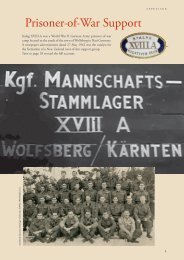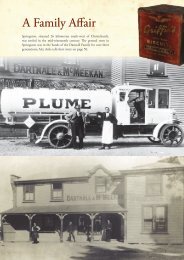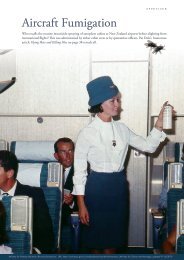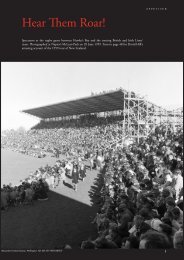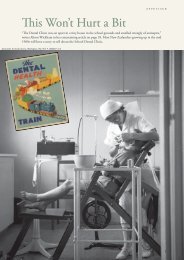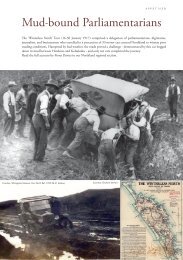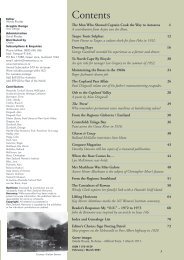New Zealand Memories Issue 151
You also want an ePaper? Increase the reach of your titles
YUMPU automatically turns print PDFs into web optimized ePapers that Google loves.
WORLD WAR II<br />
By the end of 2019 the golf greens had gone, the<br />
new roads had been laid and plots had been surveyed<br />
for over fifty new homes. It was common knowledge<br />
that during World War Two the grounds were used as<br />
a camp for both <strong>New</strong> <strong>Zealand</strong> and American soldiers,<br />
but this had begun to fade from memory. In honour<br />
of the site’s military past the developers, Westwood<br />
Property Group, named the new housing site The<br />
Barracks.<br />
In September 1939 the United Kingdom declared war<br />
on Germany. Being part of the British Commonwealth,<br />
<strong>New</strong> <strong>Zealand</strong> followed suit and began to recruit men<br />
to help Britain in her war against Nazi Germany. For<br />
two years young <strong>New</strong> <strong>Zealand</strong> men trained and sailed<br />
for the European war. Meanwhile life continued back<br />
home. Masterton still held its annual Agricultural and<br />
Pastoral shows at the Solway Showgrounds. It wasn’t<br />
until Japan’s entry into the war in December 1941 that<br />
this began to change. With the war much closer to<br />
home, more troops were needed for the Pacific to help<br />
defend against the coming threat. <strong>New</strong> training camps<br />
were set up across <strong>New</strong> <strong>Zealand</strong> to meet the demand<br />
and the showgrounds at Solway were seen as an ideal<br />
site. The 1942 show was cancelled and the Ruahine<br />
Infantry Regiment of the <strong>New</strong> <strong>Zealand</strong> army moved<br />
into the grounds for training and deployment to the<br />
Pacific.<br />
Half a world away, another group of young men<br />
were involved in the same conflict. A month after<br />
<strong>New</strong> <strong>Zealand</strong> declared war on Germany, the Third<br />
Defense Battalion of the United States Marine Corps<br />
was formed. This was in response to the actions of<br />
Germany but also of Japan, whose expansion into the<br />
Pacific was causing alarm.<br />
In April 1940 the battalion boarded a ship and sailed<br />
for Pearl Harbor. They remained there for ten months<br />
and then sailed for Midway Island where they helped<br />
build up the atoll’s defences. By September 1941 the<br />
USMC were back at Pearl Harbor. They were there<br />
on December 7 when the Japanese attacked and were<br />
quick to join in the defence of the base. By the end of<br />
the raid three of the attacking planes had been shot<br />
down.<br />
In May 1942 half the battalion was sent back to<br />
Midway where they helped defend the atoll against<br />
the Japanese attack on June 4. From here it was back<br />
to Pearl Harbor to resupply before they were sent to<br />
their next battleground, the island of Guadalcanal in<br />
the Solomon Islands. The Japanese had been building<br />
an airstrip on the island which would be a threat to<br />
Australia when competed. For six months the Third<br />
Defense Battalion was stationed in the Solomons,<br />
defending against air and sea attacks by the Japanese,<br />
who were determined to recapture the airfield. By<br />
February 1943 the troops were exhausted and sick<br />
with malaria. They were told they would be taking<br />
some time off for rest and retraining, and they would<br />
be doing this in <strong>New</strong> <strong>Zealand</strong>. On February 9 the<br />
battalion boarded the USS George Clymer and sailed<br />
for a safer world. 1<br />
On February 16 the battalion arrived in Wellington.<br />
From here an advance party went by train to the<br />
Solway Showgrounds in Masterton. 2<br />
The advance group was tasked with making<br />
preparations ahead of the arrival of the rest of the<br />
battalion. The <strong>New</strong> <strong>Zealand</strong> Ruahine Regiment had<br />
left a few months before and tents and facilities had to<br />
be put in order in the now vacant camp. In March the<br />
remainder of the battalion arrived at the showgrounds.<br />
Dressed as they were for Guadalcanal, their summer<br />
uniform was inadequate for the much colder <strong>New</strong><br />
<strong>Zealand</strong> climate. One Marine recalled “the first chance<br />
I had I went over the top and shot into Masterton and<br />
picked myself up a nice double eiderdown. I didn’t get<br />
cold from then on.” 3<br />
For the first two weeks in Masterton, the Marines<br />
settled in to their new home. Most stayed in tents, six to<br />
each, which were warmed by stoves supplied by the locals.<br />
Others utilised the showgrounds existing buildings. The<br />
majority camped in the main showgrounds area but<br />
there were several tents pitched on the northern field<br />
which is shown on a wartime plan. Cook houses,<br />
shower blocks and latrines had all been installed prior<br />
to the Americans arriving at camp, although there were<br />
complaints that the hot water in the shower blocks was<br />
lukewarm at best.<br />
After two weeks the troops were still without proper<br />
supplies and began to grow restless. They had brought<br />
some gear with them, which included a souvenir<br />
Japanese bullet casing from Guadalcanal (rediscovered<br />
during excavations), but they were still short of warm<br />
clothes and luxury items. To appease the men, a supply<br />
of 700 bottles of American beer and a large amount of<br />
ice cream was sent up by train. 4 The main food supplies<br />
were provided locally and included meat, vegetables,<br />
fruit and tinned goods which had been brought in<br />
from overseas.<br />
1 Theodore R. Walker, History of the Third Defense Battalion, Fleet<br />
Marine Force U.S. Marine Corps, p. 1-24.<br />
2 3D Defense Battalion, 1265-leb, 1-3.<br />
3 Wairarapa Archive, Oral History 484.<br />
4 Ibid<br />
United States Marine Corps site Solway just after US Marines left. November 1943.<br />
Inset: USMC site looking over bush to northern field. Courtesy: Wairarapa Archive<br />
6




